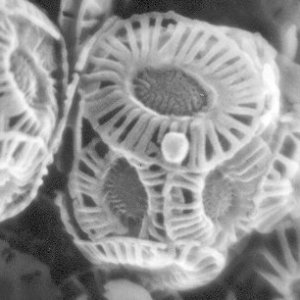A giant among viruses could delay ageing and the effects of terminal diseases
 A virus with a gigantic genome that infects chalk-covered marine algae contains compounds that could be developed for use in anti-ageing and cancer-inhibiting therapies.
A virus with a gigantic genome that infects chalk-covered marine algae contains compounds that could be developed for use in anti-ageing and cancer-inhibiting therapies.
This important discovery was made when researchers at the Plymouth Marine Laboratory and colleagues at the Wellcome Trust Sanger Institute in Cambridge unravelled the genetic code of the largest algal virus, called Emiliania huxleyi virus 86, ever analysed. Their findings are reported in the journal Science, published 12 August 2005.
The team unearthed a cluster of genes responsible for the production of ceramide, a key component of anti-wrinkle and anti-ageing creams. These genes have never before been found in a virus – they are more commonly seen in animal and plant cells.
Ceramide can control mechanisms in the cell that lead to ‘programmed cell death’. These processes are important in normal development and in diseases such as cancer. This mechanism is seen when a tadpole’s tail is resorbed as it grows into a frog.
“For an invading virus, the ability to control when your host will die and ensure your own survival is quite incredible. Essentially the virus hijacks the cell and slows down the ageing process by keeping it healthy for as long as possible. It uses the cell as a kind of factory to replicate itself and eventually takes over completely, killing off the cell.”
Dr WH Wilson
The genome of this virus Which consists of 407,000 letters of genetic code – contains almost as many genes as Mycoplasma, a simple celled organism.
“The genome is remarkably different to other viruses and proved to be a real challenge to decode. The genetic map provides a tantalizing glimpse of the potential benefits locked within, but many of the gene secrets of this mysterious leviathan still remain to be unravelled.”
Dr Matthew Holden leader of the Sanger Institute’s analysis team
The discovery of viral ceramide will be of great interest to scientists and industries looking for new sources of novel compounds for use in medicines and cosmetics.
“This virus really is a giant. Most viruses only have a few genes – HIV, for example, has only nine – while this algal virus has 472 genes. We’ve only just scratched the surface – much more work is needed to understand what function most of the genes actually perform.”
Dr WH Wilson
The virus appears to infect only the chalk-covered marine algae species (Emiliania huxleyi) that form beautiful ‘blooms’ on the surface of the sea, soaking up billions of tonnes of carbon dioxide from the atmosphere. Incredibly, during infection the virus is also thought to control climate through production of a gas (dimethyl sulphide) that helps clouds to form.
More information
- The research was funded by the Natural Environment Research Council (NERC) through grants to the Marine Biological Association and the NERC Environmental Genomics programme.
- The DNA sequencing and computer analysis was carried out at the Wellcome Trust Sanger Institute in Cambridge. The Wellcome Trust Sanger Institute is one of the leading genomics centres in the world, dedicated to analysing and understanding genomes. Through large-scale analysis – and focused research and collaborations – the Sanger Institute’s programmes underpin biological and medical research worldwide.
- The Plymouth Marine Laboratory (PML) is an international centre of excellence for interdisciplinary marine chemical, biological and ecotoxicological research. PML’s research places particular emphasis on understanding the mechanisms controlling biological production and the role of microbially driven biogeochemical processes, exchanges and controls, estuarine and coastal function and health, biodiversity, remote sensing, bio-optics and marine genomics.
- The Marine Biological Association of the United Kingdom (MBA) is a professional body for marine biologists with some 1200 members world-wide. The MBA has earned an international reputation for excellence and innovation in research, by the resident scientific staff and visiting research workers, including seven Nobel laureates.
- In-depth analysis of virus genes was conducted in collaboration with the Scottish Centre for Genomic Technology and Informatics (scGTI) in Edinburgh. Their mission is to accelerate discovery and research enterprise through co-operation, collaboration and the fusion of scientific disciplines in order to advance our ability to educate, understand and treat human health and disease.
- The Natural Environment Research Council is one of the UK’s eight Research Councils. It uses a budget of about £350m a year to fund and carry out impartial scientific research in the sciences of the environment. NERC trains the next generation of independent environmental scientists.
Websites
- Publication (doi: 10.1126/science.1113109)
- Project Pages – https://www.sanger.ac.uk/Projects/EhV/
- Plymouth Marine Laboratory – http://www.pml.ac.uk
- Marine Biological Association – http://www.mba.ac.uk
- Scottish Centre for Genomic Technology and Informatics (scGTI) – http://www.gti.ed.ac.uk
- Natural Environment Research Council – http://www.nerc.ac.uk
- GeneDB information for EhV86 – http://www.genedb.org/genedb/ehuxleyi/
Publications:
Selected websites
The Wellcome Trust Sanger Institute
The Wellcome Trust Sanger Institute, which receives the majority of its funding from the Wellcome Trust, was founded in 1992. The Institute is responsible for the completion of the sequence of approximately one-third of the human genome as well as genomes of model organisms and more than 90 pathogen genomes. In October 2006, new funding was awarded by the Wellcome Trust to exploit the wealth of genome data now available to answer important questions about health and disease.
The Wellcome Trust and Its Founder
The Wellcome Trust is the most diverse biomedical research charity in the world, spending about £450 million every year both in the UK and internationally to support and promote research that will improve the health of humans and animals. The Trust was established under the will of Sir Henry Wellcome, and is funded from a private endowment, which is managed with long-term stability and growth in mind.


